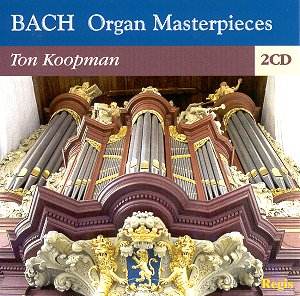Johann Sebastian BACH
(1685-1750)
Organ Masterpieces
Disc 1
Prelude and Fugue in D major BWV 532
Toccata, Adagio and Fugue in C major BWV 564
Prelude and Fugue in A minor BWV 543
'Dorian' Toccata in D minor BWV 538
Fantasia in G major BWV 572
Chorale: 'Liebster Jesu, wir sind hier' BWV 730/1
Passacaglia and Fugue in C minor BWV 582
Fantasia in C minor BWV 562
Disc 2
Prelude and Fugue in E flat major 'St Anne' BWV 552
Partita '0 Gott, du frommer Gott' BWV 767
Fantasia (Prelude) and Fugue in G minor BWV 542
Chorale: 'Nun komm' der Heiden Heiland' BWV 659
Chorale: 'Wachet auf, ruft uns die Stimme' BWV 645
Chorale: 'Ich ruf zu dir, Herr Jesu Christ' BWV 639
Toccata and Fugue in D minor BWV 565
 Ton Koopman,
organ Ton Koopman,
organ
Rec: not specified (late
1980s)
 REGIS RRC 2042
[131.47] REGIS RRC 2042
[131.47] |
 |
| Available for around £6 per disc from your
dealer |
Bach's fame as an organist was well-known during his life. He travelled far
to hear the great organists of his time - once even travelling more than
250 miles, by foot, to hear Buxtehude play in Lübeck. That incident
got him in some trouble, since he had asked for three weeks' leave and only
returned after three months.
The organ was the essential instrument in Lutheran liturgy. It was used to
play "background" music before and after masses, to play chorales, or hymns,
and to accompany other works, such as cantatas and passions. A kantor had
to be a musician and composer, among others, responsible for composing and
performing sacred works, but, above all, his skills as an organist were
considered fundamental.
Bach's organ music ranges from the majestic to the intimate, from grandiose
works that stretch the instrument to its limits, to simple, meditative pieces
that inspire emotion and piety. Organ music, more than most instrumental
music, is highly dependant on the quality of the instrument it is played
on - the great organs have sonorities that amaze and enlighten.
This selection of Bach's organ works is performed by Ton Koopman, currently
one of the greatest performers of Bach's music in all its forms. He is a
harpsichordist, organist, and conductor. He plays on three of the best organs
in the Netherlands: the Garrels organ in Maassluis, the Christian Müller
organ in Leeuwarden, and the Dreifaltigkeits organ in Ottebeuren.
There is a fine cross-section of Bach's works here, starting with the majestic
Prelude and Fugue in D major BWV 532, that opens this recording, with
its use of the full range of the magnificent Garrels organ. The prelude is
relatively free and unstructured, with long runs along the keyboard, in the
French overture style. Its companion fugue shows Bach at his most inventive,
as he takes a simple subject and weaves it through modulations and variations,
with its splendid descending chords.
The Prelude and Fugue in A minor BWV 543 opens with a brilliant toccata,
with an upper voice meandering over a sustained pedal note, followed by virtuoso
runs as Bach shows off his talent. Its fairly long fugue is similar to many
of the fugues Bach wrote in the Well Tempered Clavier, with a long
subject reappears throughout the work in slightly different forms.
One of the highlights of this recording is the massive Passacaglia and
Fugue in C minor BWV 582, which is Bach's only work of this type. Beginning
with a solemn subject of only 16 notes, over 4 bars, with an implied chord
sequence, there are 20 variations on this theme as Bach embellishes, ornaments,
and embroiders the overlying structure as the theme is repeated, first in
the bass, then later in the treble, only to come back to the bass. One of
Bach's most intriguing pieces, this early work is a presage of his later
compositions involving variations, such as the Goldberg Variations.
This recording includes several church chorales, short works, often more
restrained than Bach's larger scale pieces, which are based on Lutheran hymns.
Used to accompany or introduce hymns, or to act as interlude between verses,
Bach turned these seemingly simple songs into miniature works of art. The
four Chorales included on this recording all represent Bach's meditative
side. Simple two or three-voice works, they do not use the grandeur of the
organ to express their deep feeling, but provide simple settings of hymns
with subtle, sometimes melancholy accompaniment. While Bach wrote other chorales
that are more lively, this aspect of his work is perhaps the most touching.
The recording ends with the famous Toccata and Fugue in D minor BWV 565.
A work from Bach's youth (if by him at all; this has been contested), this
is his best-known organ work. While some musicologists suggest that this
might actually have been written for violin (it has been recorded by Andrew
Manze, and is, indeed, playable on the violin), it is probably the best showpiece
for any organ. Koopman obviously enjoys himself, as he plays this work with
unequalled energy and pizzazz. Every facet of the organ is exploited in this
piece, and every ounce of the organist's skill is called into play, as the
wild melodies fly from one end of the keyboard to the other. In no other
work does one hear such a range of techniques and styles together.
Ton Koopman shows himself to be one of the best interpreters of Bach's organ
music, and takes full advantage of the extraordinary organs he recorded these
works on.
This recording features a selection of some of Bach's best organ works, played
on some of the best sounding organs available. An excellent set, well worth
buying for the music, the performance, or the sound of the organs; or perhaps
all three.
Kirk McElhearn

